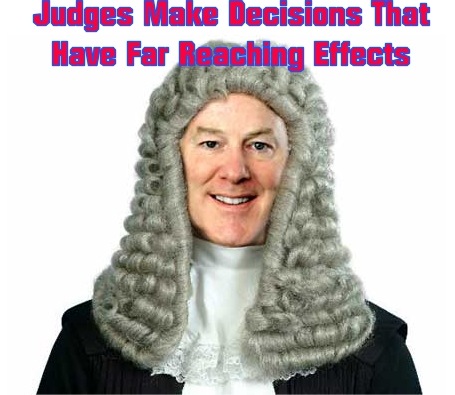Texas judge, Rick Morris has made a decision that you might want to know about. I couldn’t find a picture of Rick, so the picture above is of a British judge because it looked so much better than most photos of U.S. judges. Now I am not a regular lawyer and there a lot of people who know a lot more about law than I do. These people are usually referred to as attorneys or lawyers – as in someone with a law degree.
To read all about it click here.
The problem you may have is that Rick wasn’t the only one, the plaintiff got someone else to agree: Alan Waldrop. Justice Waldrop is the presiding judge for the Texas Appellate Court, District 3, in Austin.
To summarize what occurred: Jason and Ashley Bradford bought a house. They were in possession of the house for about a month prior to closing. After closing on the house and officially owning it they get a copy of the appraisal and see that the square footage stated in the listing is different than that shown in the appraisal. The listing said 1,824 square feet, the appraisal said 1,571 – a difference of 253 feet. The buyers sued. The buyers claimed they thought they were paying $65.52 a foot and instead paid $76.07.
It was pointed out at trial and at the appeals court that the listing agent used the square footage information shown on the Bell County Tax Appraisal District and had no reason to suspect it was wrong. Further, the buyers had been to that site several times looking up information on the property.
But it was wrong and the agent lost in court. And again at the appellate level. Specific analysis of both trials with various legal opinions here. In short: the listing agent pays damages for buyer’s square footage difference.
Just a thought – it just might be a good idea to personally verify any information or “fact” we pass along to a client or customer.
Russell has been an Associate Broker with John Hall & Associates since 1978 and ranks in the top 1% of all agents in the U.S. Most recently The Wall Street Journal recognized the Top 200 Agents in America, awarding Russell # 25 for number of units sold. Russell has been featured in many books such as, "The Billion Dollar Agent" by Steve Kantor and "The Millionaire Real Estate Agent" by Gary Keller and has often been a featured speaker for national conventions and routinely speaks at various state and local association conventions. Visit him also at nohasslelisting.com and number1homeagent.com.





































Matt Stigliano
November 28, 2008 at 7:54 am
Russell – As an agent and resident of Texas, this was quite the post to read this morning. I’m all for consumer protection, but it really is going a bit too far. Should we know hire appraisers before listings, so we can have an expert judge the home? What if the appraiser made a mistake and the appraisal district were correct? Who’s more of an expert in this case? The appraisal district in Bexar County is often all over the place with their judgments of value on the home, so I can see where they would be viewed as the lesser of experts in the matter, but maybe that just points to a flaw in the system that needs to be fixed? If you can’t rely on the body trusted with determining a tax valuation for your home, perhaps we’ll all paying too much or too little (and I see it everyday here in San Antonio). I think I will be a bit more careful in pointing out to people that although I have information regarding square footage, I am not the source and am not a qualified appraiser, so I can not give an accurate depiction of the number. Guess I ought to go get an appraisers license now?
Elaine Reese
November 28, 2008 at 9:06 am
I think you could easily have 3 different appraisers measure and come up with 3 different sq footages, especially if there are any open vaulted ceilings.
I’ve had a couple experiences with discrepancies. In one home, we learned that the original floor plan that the builder submitted to the auditor was slightly different than the home actually built later. The home had sold 3 times previously, with no change to the sq feet. So either the appraisers for those 3 loans had not really measured or no steps had been taken to correct county records.
In the second example I suspected that the auditor’s figure was overstated. My sellers paid an appraiser to recalculate before we put it on the market. The appraiser did the measurement but would not put it in writing because he didn’t want to be held accountable.
The sq footage is such a subjective figure. I’m surprised that the courts found that agent guilty, when the agent was merely providing data from the county records. This is an appraiser issue … and an inconsistency in the way measurements are done … not a real estate agent issue.
Missy Caulk
November 28, 2008 at 10:26 am
Russell, in our MLS we have to say, the source of the square feet. So we put in assesor, measured, builder or appraisal. I think that would relieve us of any liability but will send this over to our Board to have our attorney for MAR respond to it.
Why didn’t they look at the appraisal BEFORE closing?
I had a square foot issue once and was sued, eventually dropped from the lawsuit, but I had put in the appraisers S.F. This appraiser counted the air above the great room. We had 4 different appraisers measure before it was over and all 4 came up with different amounts.
Steve Simon
November 28, 2008 at 11:01 am
It is not the content you should worry about most (although correct data would be wonderful). The manner in which it is conveyed is the key. If there is a finate square footage, couch the information with an attribution, ie: “the home inspector’s report showed 1700 square feet”, or “the County Appraiser’s site lists the house at 1700 square feet”. When dealing as the listing agent I think its even easier to practice good “Risk Avoidance Procedure”. The real risk is when you represent the buyer! Florida courts have multiple rulings holding buyer’s agents responsible for things that they should have known (but didn’t). The definition for most cases of “should have known” is, “Would a average agent using reasonable efforts & skills been able to ascertain this”…
The buyer’s side rep. definitely has it worse than the seller’s side agent in my opinion. However as I stated above, the delivery of the information can soften potential pitfalls.
Barry Bevis
November 28, 2008 at 11:41 am
Well Florida has it figured out. Our Tallahassee Board of Realtors contract has a section that directly addresses this issue. And I always cover it in detail.
It reads:
“Square Footage: Buyer acknowledges they have not relied upon Broker’s or Seller’s estimate of square footage of property. Square footage is approximate and may have been provided by third party sources. If square footage is of concern to Buyer, Buyer is advised to personally measure the property.”
Danilo Bogdanovic
November 28, 2008 at 1:40 pm
This is a bit scary and I find it ludicrous that the judge would blame the agent. The judge that made the decision probable made it sitting in the very courthouse where the incorrect land/public records came from.
Does the local MLS there have a disclaimer at the bottom of every listing/page? Ours does. It reads:
“Information is believed to be accurate, but should not be relied upon without verification. Accuracy of square footage, lot size and other information is not guaranteed.”
I’m not a lawyer, but it seems that this would protect me from this type of lawsuit, especially since the MLS pulls a lot of the data for the listing from public records (just like the case cited in your post).
Benn Rosales
November 28, 2008 at 2:53 pm
Danilo,
we have many many disclaimers in regards to more or less where sqft is concerned. I have a feeling that this agent either had the worst attorney defending him, OR the agent made some very costly assertions to the buyers.
What I find most insane is that a buyer occupied a home prior to closing- unless this was a tenant who was renting prior to purchase, this in and of itself is unheard of.
This situation is weird and I hope NAR is aware as well as the local associations- this is the first we’ve heard of this suit, and would like to know what the boards are recommending in order that we protect ourselves into the future- this indeed is a gigantic dungheap that’s been dropped and it smells of awful lawyering if you ask me.
Paula Henry
November 28, 2008 at 6:56 pm
This is interesting! I have a current client who has lived in his home for 2 years.
He never did see his appraisal; it was his first home and he didn’t know to ask. He recently asked for and received a copy, which had the stated sq. ft. as 160 less than he thought, which means he overpaid.
The original sq.ft. was what was stated by the assessor. He had his home reassessd by the county assessor and contacted an attorney who told him he didn’t have a case.
Our contracts state the buyer is to verify all pertinent information. Yet, we still have attorneys and judges who disagree. We do need better laws and disclosures to protect us.
Matt Stigliano
November 28, 2008 at 7:11 pm
Missy – The San Antonio MLS also has the source of the square footage (although I don’t believe it was in our last MLS, we just converted to a new one this year).
Danilo – We do have the MLS disclaimer on every page.
Benn – It would be interesting to see how the lawyer handled the case and what the agent might have said to the buyers. Perhaps you are right in thinking its the root cause.
Mary Ann Daniell
November 28, 2008 at 8:28 pm
This case has been a hot topic here in the Killeen, Texas area, with plenty of comments of the “dung heap” variety made in regard to the buyers AND the legal system. The main question seems to be “where does this stop?” Realtors are not appraisers in charge of determining the value of properties (which is based on, among other things, square footage). Someone who is in the business of determining value (appraisers, central appraisal district employees) SHOULD be the authority for square footage. The agent involved in this suit made the fatal error of NOT disclosing the source of her MLS square footage. That being said, it’s obviously a good point to review and compare the appraisal square footage measurement and the appraisal district number BEFORE closing.
Dan Connolly
November 29, 2008 at 12:17 pm
In the Atlanta area we aren’t allowed to post square footage because the directors of our MLS systems who have an old school paternal attitudes are trying to save us from these types of lawsuits. It seems like it would be fairly easy to add a disclaimer that would protect the listing agent. “This information is obtained from the county tax record and no warranty of accuracy is expressed or implied.”
Dena Davis
December 3, 2008 at 11:34 am
The odd thing here is that the buyer should get their appraisal BEFORE they close on the house.
In Austin, our MLS says the square footage — then you cite per appraiser, per owner, or per builder. That kind of cleans it up a little bit. Because it’s not an absolute. Its the square footage according to the source. I had this happen to me as well.
I sold a building that the appraisal district had the wrong square footage for. The buyers lender had an appraisal with the right square footage and they recieved that PRIOR to purchase. But they never shared the appraisal with me. And the buyers didnt pick up on the correct square footage until AFTER the sale was closed.
There was no intent to defraud on the part of the listing agent or the owner.
Andy McRorie
December 22, 2008 at 10:50 pm
As Mary Ann Daniell pointed out, regardless of who’s at fault, this is an issue that needs to be dealt with. Since square footage is a huge determination of value, this is a fact that must be accurate. If Best Buy tried to sell you a 25-pack of DVD’s but really there were only 20, I believe that would be false advertising. Even though it looked like about 25, that doesn’t mean that the false representation was any less unethical.
I’m not suggesting that this is intentional by realtors. It is a factual inaccuracy purported by the county appraisers office in most cases auto-imported by MLS. The problem with their estimates is that they can’t get inside the house to measure. In any case, this sucks for a buyer. By the time they find out this piece of information, it’s usually too late in the ballgame. Aside from the fact that they’ve paid many of the costs (such as app. fee, appraisal, etc), their time is invested. Additionally, in many cases, they are relying on that date to move in. The system sucks currently, and there’s little recourse for buyers.
Somebody should be held responsible. Specifically, I believe that the seller should be required to get an appraisal done upfront by a “certified” appraiser. Not only will this provide an accurate square footage, but as well this would provide an accurate idea of what the home is worth before pricing it. This appraisal could then be used by the lender. The government, of course, would need to be involved at some level to ensure that most/all lenders approve of the certification of these appraisers.
In any case, this issue is an abomination to the world of real estate. Relying on a “guestimation” as a source of very vital information is a ridiculous mistake unmatched in any other industry. Something must be done! While the realtor really shouldn’t be the scapegoat, perhaps it might help to inspire some course of action to protect buyers.
Mary Steward
May 18, 2009 at 8:53 pm
I have a problem that I am trying to solve that is something similar to this. I have a house that the appraiser put in an appraisal of 1701 square feet. However, the Bexar County Appraisal District has the house at 1185 square feet. A difference of 516 square feet. There was an addition put on the house which the previous owner’s did not obtain permits to build and there are a lot of problems with the addition’s foundation, roof, electrical etc. In order to sell the house I have to pull permits that the previous owner’s did not pull, have the addition inspected and make any corrections to the addition or tear the addition off and lose the extra 536 sq ft that I paid for? I cannot find an attorney to take this case. Do I have a law suit? If so, do I sue the brokers that brokered the house, there was no agent, or do I sue the owners or the appraiser? Or do I go the the title company for not finding the discrepancy when they did the title search? Who is responsible for the error and correcting the error if I don’t find out until after the fact?
Steve Crossland
December 1, 2009 at 10:37 pm
This case doesn’t change anything. I don’t know how to explain it in legal terms, but I called the TAR Legal Hotline back when it happened and it was explained to me that the outcome doesn’t change case law on the matter. Also, this agent in this case did not disclose the source of the sqft, which is a no no. You must disclose the source of the info. Basically the Broker didn’t want to spend money taking it to the next level, where it probably would have been reversed. It’s one of those “cost more to win than to settle” type of things.
If you’re a Realtor and want to better understand what I’m talking about, call the TAR Legal Hotline and ask them for an explaination. I’m surprised one hasn’t been published because it’s caused a lot of confusion. If you follow you MLS rules, and you simply report third party info and the source, you should always be ok.
Steve
Evan Jarvis
September 22, 2010 at 2:48 pm
There are standards of measurements used and accepted world wide. Hire a licensed surveyor to locate your house on your property and locate a corner of your house by surveyor units and legal description. Then have a surveyor measure the house. Then declare ANSI or BOMA standard of measurement. Remember it might be useful to know the type of exterior or veneer on your home depending on the standard of measurement.
ANSI Standard: Square Footage Measurement in Single-Family Homes & Condos
DEFINITIONS
Attached Single-Family House – A house that has its own roof and foundation, and that is
attached, yet separate, by walls from roof to foundation
Detached Single-Family House – A house that has open space on all its sides
Finished Area – Enclosed area of a house that is suitable for year-round use, including
walls, floors, and ceilings that are similar to the rest of the house
Garage – A structure intended for the storage of automobiles or other vehicles
Grade – The ground level at the perimeter of the outer finished surface of a house
Level – Areas of the house that are vertically within 2 feet of the same horizontal plane
Square Footage – An area of a house that is measured and calculated with use of the
standard
Unfinished Area – Sections of a house that do not meet the criteria of finished area
CALCULATION OF SQUARE FOOTAGE
To claim use of this standard, the following methods of calculation must be applied when
quantifying square footage in single-family houses. When using English measurements,
the house is measured to the nearest inch; the final square footage is reported to the
nearest whole square foot.
Calculation Methods
Calculating square footage using the outer dimensions of a house without inspection of
the interior spaces is allowed, but this must be stated as such when reporting this
calculation.
Circumstances may occur in which direct measurement of a structure isn’t possible (i.e.
access may be unavailable due to the nature of the terrain, structure, or other obstacles).
Dimensions acquired through some means other than direct measurement may
susceptible to inaccuracy, and so can the calculated area. Obtainment through such a
method must be stated when reporting calculations.
Detached Single-Family Finished Square Footage
The finished square footage of each level is the sum of finished areas on that level
measured at floor level; or by using the outer finished surface of the outside walls.
Attached Single-Family Finished Square Footage
The finished square footage of each level is the sum of the finished areas on that level
measured at floor level; or by using the outer finished surface of the outside walls; or
from the centerlines between houses, where appropriate.
Finished Areas Adjacent to Unfinished Areas
When finished and unfinished areas are adjacent on the same level, the finished square
footage is calculated by measuring to the outer edge or unfinished surface of any inside
space between the areas.
Openings to the Floor Below
Openings to the floor below can’t be included in the square footage calculation. But the
area of stair treads and a landing, proceeding to the floor below, is included in the
finished area of the floor from which the stairs go down, not to exceed the area of the
opening in the floor.
Above- and Below-Grade Finished Areas
The above-grade finished square footage of a house is the sum of finished areas on levels
that are entirely above grade. The below-grade finished square footage of a house is the
sum of finished areas on levels that are fully or partly below grade.
Ceiling Height Requirements
To be included in finished square footage calculations, finished areas must have a ceiling
height of at least 7 feet, except under beams, ducts, and other obstructions, at which may
be 6 feet, 4 inches; under stairs where there is no specified height requirement; or where
the ceiling is sloped. If a room’s ceiling is sloped, at least one-half of the finished square
footage in that room must have a ceiling height of 7 feet; no portion of the finished area
that has a ceiling height of less than 5 feet may be included in finished square footage.
Finished Areas Connected to the House
Finished areas that are connected to the main body of the house by other finished areas
(Hallways, stairways, etc.) are included in the finished square footage of the floor that is
at the same level. Finished areas that are no connected to the house in such a manner
cannot be included in the finished square footage of any level.
Garages, Unfinished Areas, and Protrusions
Garages and unfinished areas cannot be included in the calculation of finished square
footage. Chimneys, windows, and other finished areas that protrude beyond the outer
finished surface of the outside walls and do not have a floor on the same level cannot be
included in the calculation of square footage.
STATEMENT OF FINISHED SQUARE FOOTAGE
Failure to provide declarations listed below – where applicable – voids any claim of use
to this standard.
Rounding
The finished square footage of a house is to be reported to the nearest whole square foot
for above- and below-grade finished square footage.
Reporting of Above- and Below-Grade Areas
No statement of a house’s finished square footage can be made without the clear and
separate distinction of above- and below-grade areas.
Areas Not Considered Finished
Finished areas that are not connected to the house, unfinished, and other areas that do not
fulfill the requirements cannot be included in the statement of finished square footage but
may be listed separately if calculated by methods explained in this standard. Also, any
calculation listed as unfinished must distinguish between above and below grade areas.
Interior Spaces Not Inspected Method
If calculations of finished square footage are made without inspections of the interior, a
declaration must be included. An example is the following:
DECLARATION 1:
“Finished square footage calculations for this house were based on measured dimensions
only and may include unfinished areas, openings in floors not associated with stairs, or
openings in floors exceeding the area of associated stairs.”
Plans-Based Method
If the calculation of finished square footage is made from the plans of a proposed house,
the Statement of Finished Square Footage must include a declaration similar to the
following:
DECLARATION 2:
“Finished square footage calculations for this house were made based on plan dimensions
only and may vary from the finished square footage of the house as built.”
Other Methods
Circumstances may exist when direct measurement of a structure isn’t possible.
Obstructions (such as those listed previously) may exist which disallow direct
measurement. If calculations are made through some means other than direct
measurement or plans can be susceptible to inaccuracy, as is the calculated area.
Calculations developed under such circumstances must include a declaration similar to
the following:
DECLARATION 3:
“Finished square footage calculations for this house were made based on estimated
dimensions only and may include unfinished areas, or openings in floors not associated
with stairs, or openings in floors exceeding the area of associated stairs.”
CLOSING STATEMENTS
This standard may not be applied to multi-family homes and/or apartment buildings. It
may be applied, though, to all detached and attached single-family homes, including
townhouses, row houses, and other side-by-side apartments.